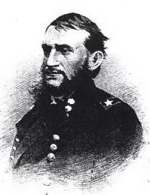Town of Mount Olive

Lt. General Judson Kilpatrick
The Yankees In Mount Olive
Reprinted with permission of the Mt. Olive Tribune and cannot be
reproduced without permission. "Our Heritage" - 1979, by Claude Moore.
Injury & insult were added to misery in the little village of Mount Olive
when Sherman's Cavalry Commander Lt. General Judson Kilpatrick arrived to
go into encampment on March 24, 1865 & to remain here until April 10th.
Even though the telegraph line had been cut, news had already reached
Mount Olive that Gen. Lee's lines were weakening at Petersburg. The yankee
army under Gen. Alfred H. Terry had passed to the west of the village
enroute to Bentonville & had burned Thunder Swamp Baptist Church;
Confederate money had become almost without value & food was scarce.
An enemy army of 4,200 uninvited guests was too much for a region which had
already seen four years of war. The country from Savannah to Wayne had been
devastated by Sherman's Army. Gen Kilpatrick reported to the United States
War Department on March 24, 1865 from his headquarters in Mount Olive that
his calvalry alone had destroyed the following from the time the departed
for Savannah on January 28th: captured 330 prisoners; burned two railroad
bridges; destroyed 10 flat cars, 5 box cars, 20,000 bales of cotton, 500
bushels of meal, 77 barrels of molasses, 90 barrels of salt, 170 saw mills,
& 7 wagon shops; & this does not include the foraging on the country to
supply his cavalry.
Mount Olive was a small village in 1865, but it did have a depot (rebuilt),
several turpentine distilleries, a Confederate Commissary, a few stores &
a few saloons & a blacksmith shop operated by Mr. Oliver Summerlin.
Mr. L. W. Kornegay was the station master & he owned a tract of land which
lay between the new Mount Olive Campus & downtown. The Robert Williams house
was standing at that time (now the home of Mr. & Mrs. Clyde Williams) &
several yankee officers made their headquarters there. The old part of the
Robert Holmes home on Center Street & the old part of the Wooten Oliver
house (built by Willis Cherry) were both built prior to the war.
The yankees camped on land mostly owned by L. W. Kornegay & included an area
from Church Street westward to the present Mount Olive Junior High School,
the farm now owned by Miss Marie Lewis & the southeast corner of the new
Mount Olive College Campus, back to the railroad. The hospital tent was
located on the lot owned by Mrs. Rodney Southerland at the intersection of
West John Street & North Martin Street. Several yankee soldiers died here
& are buried in the Maple Grove Cemetery.
Miss Marie Lewis, whom I consider the real authority on Mount Olive local
history, says that the yankee commissary was located near her present home
& that a lot of her information about the yankee occupation came from two old
slaves, Aunt Flora who belonged to the Slocumb family & Uncle Counce who
belonged to the Oliver family.
The Union Army in Wayne was supplied with food & uniforms while stationed
here. These supplies came from Wilmington & Beaufort by train. The old
uniforms were discarded near the camp & this accounts for the large number
of uniform buttons found during the years. Miss Lewis tells the story of
Uncle Counce Wooten hearing about the yankees having a commissary near town
& he went out to the location on the day after the yankees had left. He
found a pile of discarded uniforms & picked out an officer's coat with gold
braid & epaulets & wore it home. He met a mounted Cofederate soldier who
halted him, thinking that he had enlisted in the yankee army.
Uncle Counce explained to him how he had gotten the coat, but the Confederate
cut the gold braid off with his sword & let him go. Many of the old residents
of Mount Olive often mentioned how they remembered the piles of uniforms
in the woods where the yankees had camped.
Gen Kilpatrick, a native of New Jersey & a graduate of West Point in 1861,
was just 29 years old when he came to Mount Olive. After the war, he was
Minister to Chile & died there in 1881.
Kilpatrick's Cavalry was made up of four brigades. The First Brigade was
composed of the 3rd Indiana Batallion, the 8th Indiana, the 2nd Kentucky
& the 9th Pennsylvania. The Second Brigade (commanded by Brig. Gen. Smith
Atkins) was made up of the 92th Illinois, the 9th Michigan, the 9th Ohio,
10th Ohio, 21st McLaughlin's Ohio Squadron. The Third Brigade which camped
at Faison, NC, was composed of the First Alabama (probably Confederate
renegades of freed men), the 5th Kentucy, the 5th Ohio & the 13th
Pennsylvania. The Fourth Brigade was an artillery outfit attached to the
Calvary & was made up of the 10th Wisconsin & the 23rd Battery of New York
Light Artillery.
While the yankees were in Mount Olive, they complained about the rain & the
reports tell about the almost impossible roads between Fayetteville & Mount
Olive & Goldsboro. The Army of Infantry literally had thousands of wagons
in the wagon trains. In fact, it took 85 wagons to carry Sherman's pontoon
bridges.
Kilpatrick broke camp on April 10, 1865 & moved with Sherman's reorganized
army on to Smithfield where they received word on April 12 the news of Gen.
Lee's surrender in Virginia.
Buildings on Main Street
Buildings on Main Street
Buildings on Main Street
Buildings on Main Street
Buildings on Main Street
Buildings on Main Street
Buildings on Main Street
Buildings on Main Street
Buildings on Main Street
Home on Main Street
Home on Main Street
Home of Mt. Olive College
College Chapel
First Classroom on New Campus
Home of Mt. Olive Pickle Company
|